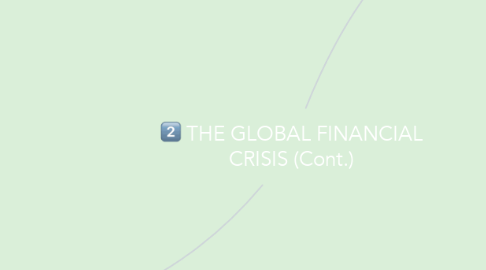
1. CHAPTER 2 : THE THREE PHASES OF CREDIT CRISIS
1.1. PHASE 1 :CREDIT CRISIS IN THE MORTGAGE MARKET
1.1.1. February 2007: Homes Sales Peak In February 2007, existing home sales peaked at an annual rate of 5.79 million. Prices had already begun falling in July 2006. Some said it was because the Federal Reserve had just raised the fed funds rate to 5.37%.
1.1.2. The Bubble Bursts : Banks began to lend recklessly to families and individuals without true means to follow through on the mortgages they’d been granted. Such high-risk (subprime) loans were then inevitably bundled together and passed down the line.
1.1.3. The Aftermath of the Global Financial Crisis of 2008-2009 : Many who took out subprime mortgages eventually defaulted. When they could not pay, financial institutions took major hits. The government, however, stepped in to bail out banks. The housing market was deeply impacted by the crisis. Evictions and foreclosures began within months.
1.1.4. Began during the summer of 2007 when German savings bank IKB & British bank Northern Rock failed. The extent of the problems caused by the decline in ABS values caught many investors by surprise & induced a second stage of the crisis.
1.2. PHASE 2 :THE CRISIS SPREADS - LIQUIDITY RISK
1.2.1. As the scale of the liquidity crisis spread far beyond the subprime market, central banks became increasingly concerned and opened their discount windows to the banks and other financial institutions that were liquidity constrained.
1.3. PHASE 3 : THE LEHMAN FAILURE - UNDERWRITING & POLITICAL INTERVENTION
1.3.1. Lehman took it to the next level between 2003 and 2004 by extending into loan origination - acquiring, among three other lenders, BNC Mortgage and Aurora Loan Services - both of which specialized in subprime loans.
1.3.2. Between 2004 and 2006, the capital markets unit surged 56% due to Lehman's real estate businesses - causing the firm to become one of the fastest-growing investment banking and asset management businesses than any other. By 2007, Lehman was reporting big numbers - with $19.3 billion in revenues and a record $4.2 billion net income
1.3.3. But things were about to take a drastic turn for the banking giant. In the first week of September, Lehman's stock dropped drastically - about 77%. Investors' doubts were growing as CEO Richard Fuld attempted to keep the firm afloat by selling off asset management units, trying to develop a relationship with Korea Development Bank for aid, and spinning off commercial real estate assets. Once it was clear to investors that Lehman was sinking, an upsurge in credit default swaps on its debt of some 66% and the backing-out of hedge fund investors signaled everyone was jumping ship. While there were several factors contributing to its collapse, many experts seem to agree that it was in large part due to a lack of trust, over-leveraging, poor long-term investments, and shaky funding.
2. CHAPTER 3 : THE CRISIS & REGULATORY FAILURE
2.1. RESTRUCTURING PLANS
2.1.1. The paulson 2008 Blueprint
2.1.1.1. Short-Term Crisis-Related Recommendations
2.1.1.1.1. The Paulson blueprint provided 3 areas of response to the financial crisis: 1) Revamp the president's working group on financial market 2) Formulate a mortgage Organization Commission 3) broaden access to liquidity and funding
2.1.1.2. Medium-Term Regulatory Restructuring Recommendations
2.1.1.2.1. The Paulson blue-print provided additional recommendations to improve the efficacy of financial regulation in the medium-term.
2.1.1.2.2. One suggestion was to eliminate the thrift charter. Another was to transfer supervision of state-chartered banks to a federal regulator, such as the Federal Reserve or the FDIC in order to eliminate the dual banking system of federal and state charters
2.1.1.3. Long-term suggestion for an Optimal Supervisory Framework
2.1.1.3.1. The Paulson blueprint views the functional system of regulation with separate charters and regulatory agencies for banking, insurance, securities, and futures to be outdated, duplicative, and inefficient.
2.1.2. The Senior Supervisor Group (SSG) Plan
2.1.2.1. Their recommendations for improved risk modeling centered on implementation of the Basel II.
2.1.2.2. This Senior Supervisors Group (SSG) identified four risk measurement and management shortcomings that hampered a bank’s ability to withstand the current crisis: (1) lack of effective firmwide risk identification and analysis (2) inconsistent application of rigorous and independent valuation models throughout the financial institution (3) ineffective management of funding liquidity, capital, and the balance sheet (4) gaps in informative and responsive risk management practices and reporting.
2.1.3. The 2009 Obama-Geithner Plan
2.1.3.1. Promote Robust Supervision and Regulation
2.1.3.1.1. Obama-Geithner Plan would be to empower the Federal Reserve to supervise on a consolidated basis systemi- cally important (due to size, leverage, and/or interconnectedness) financial holding companies (FHCs) that are considered to be too big to fail.
2.1.3.2. Establish Comprehensive Regulation of Financial Markets.
2.1.3.2.1. The Plan advises the SEC and the CFTC to harmonize their regulations of futures and other securities.
2.1.3.3. Protect Consumers and Investors from Financial Abuse
2.1.3.3.1. The major proposal in this section of the Plan is to create a new Consumer Financial Protection Agency ‘‘to protect consumers of credit, savings, payment, and other consumer financial products and services, and to regulate providers of such products and services’’
2.1.3.4. Provide the Government with the tools it Needs to Manage Financial Crises
2.1.3.4.1. This portion of the Plan has been controversial because there are those who have called for the breaking up of TBTF financial firms into smaller, more man- ageable pieces, each of which would not be able to threaten the stability of the financial system.
2.1.3.5. Raise International regulatory Standards and Improve Regulatory Cooperation
2.1.3.5.1. The Plan calls for revision of the Basel II international bank capital requirements in order to improve risk measurement and counteract procyclical effects
